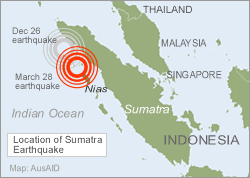A major earthquake, measuring 8.7 on the Richter scale, occurred off the coast of
northern Sumatra, on Tuesday 29 March 2005 at 2.10am EST.
As at 11 April, the Government of Indonesia estimates 676 deaths and 25,335 people injured as a result of the 28 March earthquake and aftershocks.
Australia, through AusAID, has provided an initial $1 million to respond to
the immediate and ongoing needs of communities in Indonesia, affected by a
major undersea earthquake.
The funding is being used for shelter, food, clean water and medical care -
which are en-route to stricken areas.
(Click image to view detailed map of affected area)
A four person rapid assessment team comprising AusAID, ADF and Consular
officials from Australia's Embassy in Jakarta arrived in Nias at 11am local
time on Wednesday 30 March.
They were briefed by the local police chief, made a preliminary damage
estimate and continued efforts to ensure safety of Australians in the area. Their damage estimate included:
- Roads and airfields affected
- Every fourth building in the capital collapsed
- Large numbers of dead bodies
- Water and electricity services out
- Hospital damaged, and not functioning and a lack of medical supplies
Latest News
Tuesday 12 April
A further aftershock of 6.1 on the Richter scale occurred on 11 April (11.30am Jakarta time, 2.30pm AEST) 235 kilometres northwest of Sibolga.
No further casualties have been reported as a result of the 10 and 11 April aftershocks, although damage has been reported in the Padang area.
AusAID continues to coordinate extensive assistance. The medical emergency phase is winding down but medical teams, which are focusing their efforts on sub-districts east of Sirombu, conducted medical evacuations for seven patients on 11 April, with UN assistance, and report large numbers of serious injuries.
Further reports from the AusAID-sponsored RedR engineers indicate that in the Gunung Sitoli area an estimated 50 percent of schools are habitable while 20 percent have sustained minor structural damage.
The World Food Programme, drawing on Australian financial support , delivered 300 tonnes of food aid to Simuelue on 7 April and a large cargo of food aid to Gunung Sitoli on 11 April.
Australian Assistance
A five-person Australian medical team from Banda Aceh comprising a surgeon,
a GP/Public Health specialist, a nurse with wounds management experience and a
logistician plus two nurses from Nias arrived around 1.30pm local time on
Wednesday 30 March to assist with urgent medical care.
The team equipped with two emergency medical kits, and medical supplies
including bandages and sutures from the Zainoel Abidin Hospital in Banda Aceh,
had treated more than 160 people by late Thursday 31 March.
Treatments were mainly for crush and compression injuries and open
wounds.
Critically injured patients are being evacuated by helicopter to Sibolga in
Sumatra.
The logistician rapidly assessed the hospital concluding that it had
sustained severe structural damage. The logistician will also assess outlying
areas of Nias island to help inform size, composition and location of future
medical teams.
AusAID is procuring a range of emergency supplies (fresh and dry foods,
infant formula, cooking sets, hygiene kits, shelter materials and kerosene) for
delivery to Simeulue, Banyak and Nias islands.
The World Food Programme will be providing food aid to affected communities
on Simeulue and Nias, drawing heavily on Australian financial support provided
in the aftermath of the tsunami.
Two ADF C-130 Hercules aircraft carrying humanitarian and medical supplies
as well as medical personnel arrived in Jakarta Wednesday evening (30
March).
On Friday 1 April they conducted relief flights to Sibolga carrying two
AusAID-funded doctors, emergency medical supplies, water, a forklift and
specialist rescue equipment.
The HMAS Kanimbla, returning to Australia from tsunami relief operations in
Banda Aceh was diverted back to Indonesia, arriving off the coast of Nias at
6.30am local time on Saturday 2 April.
Australia's assistance to islands off the west coast of Sumatra, begun
in the immediate aftermath of the 26 December tsunami, includes provision of
food, water, shelter equipment, medical personnel and malaria prevention to
Banyak, Simeulue and Nias islands ($1.28 million) through a local NGO, SurfAid
International.
SurfAid will continue its medical, transport and logistical support role
between Sibolga and Nias/Banyak for up to 250,000 people.
Media releases
See also:
- Australian Department of Defence [external website]
- UN Relief Web: Indonesia earthquake [external website]

